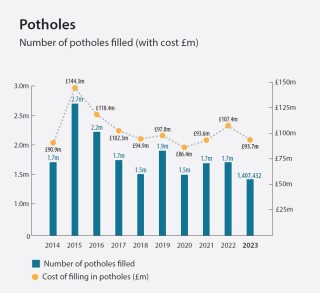This year’s Annual Local Authority Road Maintenance (ALARM) survey, published today by the Asphalt Industry Alliance (AIA), reports that local highway authorities in England and Wales only received around two-thirds of what they need to stop the rot.
Local roads are only getting resurfaced on average once every 116 years.
They now need more than £14bn to fix the backlog of repairs.
Despite the small increase in overall highway maintenance budgets reported, less work is being done carriageways. In fact, rising costs mean that engineers have reported being forced to postpone or cancel road schemes to make savings.
Data gathered from 75% of local highway authorities in England and Wales shows that in the last year the gap between what local authorities received and what they said they would have needed to prevent further decline is now £1.3bn – a jump of more than 20% on last year’s figure and the highest amount reported in 28 years of ALARM surveys.
And, the cost of fixing the backlog of carriageway repairs is reported to have increased by a further 11% on last year’s record figure to a new high of £14.02bn – the equivalent of £68,000 per mile of local road in England and Wales – and would take an average of 11 years to complete.
AIA chair Rick Green said: “Highway engineers can only do so much with the resources they are given and should be applauded for the steps they take to keep roads safe. Potholes and the condition of our local roads remain key issues for the public and the chancellor went someway to recognising this in his Spring Budget. But the additional £200m one-off payment for local roads in England, while welcome, is just not enough. It represents around 20% of the average shortfall in English local authorities’ annual budgets and will do little to improve overall structural conditions and stem further decline.
“We all appreciate that there are difficult choices to make with demands and pressures on the public purse coming from every area, but not investing in local road maintenance only leads to worsening conditions, which impact on other locally provided public services, a rising bill to fix the problem and more road user complaints.”
The findings of ALARM 2023, which relate to the 2022/23 financial year, show that 18% of the network (almost 37,000 miles) has less than five years’ structural life remaining.

While 51% of local roads are in good structural condition, 49% (more than 100,000 miles) could, without appropriate maintenance measures, continue to deteriorate to the point of needing to be rebuilt within the next 15 years.
Rick Green added: “To really improve conditions and create a safe, resilient and sustainable network, what’s needed is a longer-term funding horizon from central government with more highway budget ring-fencing. This would help local authority engineers to plan effectively and implement more efficient works to protect and enhance the resilience of the local road network.”
Steve Spender, chief executive of the Institute of Highway Engineers, said that the survey “clearly highlights the real need for a longer-term funding plan from central government to help prevent further deterioration of our local road network”.
Local Government Association transport spokesperson David Renard said: “Councils work tirelessly to repair our local roads, which are the bedrock of our economy – vital for businesses and for ordinary people going about their day-to-day lives. It is therefore alarming that, due to soaring inflation and historic funding cuts, councils’ repair backlog has grown and this has become increasingly challenging to tackle.
“To improve the condition of our roads, the government should provide a funding increase for councils, including meeting new inflationary pressures. This would help councils focus on long-term investment in existing roads, delivering preventative maintenance and reducing the occurrence of potholes in the first place, which are more expensive to repair.”
RAC head of roads policy Nicholas Lyes said: “These findings make for terrible reading and will come as no surprise to anyone who is forced to endure our pothole-plagued roads on a daily basis. It’s incredible that council funding is now so inadequate that almost one-in-five roads have under five years’ structural life left. This means the gap between the money councils have and what they need is widening – with road users ultimately left suffering.
“We’ve long campaigned for a more sustainable form of funding that allows councils to replace roads that are at the end of their useful lives. Sadly, everyone but the government appears to recognise this. This is why the government’s eternal emphasis on filling potholes is so frustrating as it’s simply treating the symptoms, and not dealing with the root cause. As a nation so dependent on road transport, we must not let this go on.”
Got a story? Email news@theconstructionindex.co.uk



